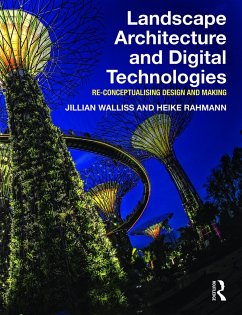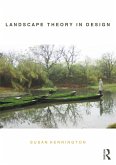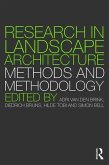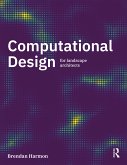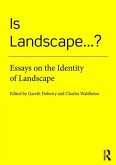Jillian Walliss, Heike Rahmann
Landscape Architecture and Digital Technologies
Re-conceptualising design and making
Jillian Walliss, Heike Rahmann
Landscape Architecture and Digital Technologies
Re-conceptualising design and making
- Broschiertes Buch
- Merkliste
- Auf die Merkliste
- Bewerten Bewerten
- Teilen
- Produkt teilen
- Produkterinnerung
- Produkterinnerung
The first theory book to focus on digital technologies in landscape architecture, with international case studies throughout.
Andere Kunden interessierten sich auch für
![Le Corbusier's Chandigarh Revisited Le Corbusier's Chandigarh Revisited]() Vikramaditya Prakash (University of Washington, Seattle, USA)Le Corbusier's Chandigarh Revisited54,99 €
Vikramaditya Prakash (University of Washington, Seattle, USA)Le Corbusier's Chandigarh Revisited54,99 €![Landscape Theory in Design Landscape Theory in Design]() Susan Herrington (Canada. University of British Columbia)Landscape Theory in Design83,99 €
Susan Herrington (Canada. University of British Columbia)Landscape Theory in Design83,99 €![Research in Landscape Architecture Research in Landscape Architecture]() Research in Landscape Architecture68,99 €
Research in Landscape Architecture68,99 €![Neuroscience for Designing Green Spaces Neuroscience for Designing Green Spaces]() Agnieszka Olszewska-GuizzoNeuroscience for Designing Green Spaces45,99 €
Agnieszka Olszewska-GuizzoNeuroscience for Designing Green Spaces45,99 €![Computational Design for Landscape Architects Computational Design for Landscape Architects]() Brendan HarmonComputational Design for Landscape Architects58,99 €
Brendan HarmonComputational Design for Landscape Architects58,99 €![Is Landscape... ? Is Landscape... ?]() Is Landscape... ?76,99 €
Is Landscape... ?76,99 €![Landscape Performance Modeling Using Rhino and Grasshopper Landscape Performance Modeling Using Rhino and Grasshopper]() Phillip ZawarusLandscape Performance Modeling Using Rhino and Grasshopper47,99 €
Phillip ZawarusLandscape Performance Modeling Using Rhino and Grasshopper47,99 €-
-
-
The first theory book to focus on digital technologies in landscape architecture, with international case studies throughout.
Hinweis: Dieser Artikel kann nur an eine deutsche Lieferadresse ausgeliefert werden.
Hinweis: Dieser Artikel kann nur an eine deutsche Lieferadresse ausgeliefert werden.
Produktdetails
- Produktdetails
- Verlag: Taylor & Francis Ltd
- Seitenzahl: 266
- Erscheinungstermin: 11. Februar 2016
- Englisch
- Abmessung: 192mm x 249mm x 16mm
- Gewicht: 708g
- ISBN-13: 9780415745857
- ISBN-10: 0415745853
- Artikelnr.: 43016343
- Herstellerkennzeichnung
- Libri GmbH
- Europaallee 1
- 36244 Bad Hersfeld
- gpsr@libri.de
- Verlag: Taylor & Francis Ltd
- Seitenzahl: 266
- Erscheinungstermin: 11. Februar 2016
- Englisch
- Abmessung: 192mm x 249mm x 16mm
- Gewicht: 708g
- ISBN-13: 9780415745857
- ISBN-10: 0415745853
- Artikelnr.: 43016343
- Herstellerkennzeichnung
- Libri GmbH
- Europaallee 1
- 36244 Bad Hersfeld
- gpsr@libri.de
Jillian Walliss has over fifteen year experience as a landscape architecture academic in Australia and New Zealand. Since 2007, she has worked in the Landscape Architecture program at the University of Melbourne where she teaches landscape theory and design studio. Jillian's research focuses on the relationship between theory, culture and contemporary design practice, exploring design within the cultural and political contexts of democracy, nationalism and post-colonialism. This work has been published in prominent international journals including the Journal of Landscape Architecture, Space and Culture, Environment and History, Museum and Society and the Journal of Australian Studies. Jillian's interest in digital technologies was initially provoked by the challenge of embedding digital technology within design studio. Her innovation in teaching with digital technologies was recognised by the University of Melbourne's prestigious Edward Brown Award and outcomes from this work have been published in the Journal of Landscape Architecture, International Journal of Art & Design Education and presented at international conferences. Heike Rahmann is a landscape architect and urban researcher at the RMIT University, School of Architecture and Design. She has worked with various practices within the fields of landscape architecture and urban design, and has been involved in partnerships with industry, community and government bodies, especially in Germany, Japan and Australia. Her research explores the intersection of landscape and contemporary urbanism with focus on design practice and theory. She has published widely on the creative, ecological and cultural manifestations of interstitial spaces, as well as on the issue of design research. Her most recent publication includes the co-authored book Tokyo Void: Possibilities in Absence (Jovis, 2014), which explores notions of vacancy and transformation processes in one of the largest urban areas in the world. Heike has taught design studios and core subjects, which introduce digital technology as tool for creative exploration and as a strategic link between design, construction and material applications. In 2012, her innovation with digital technologies in the design studio was recognised by the Melbourne Graduate School of Design Teaching Excellence award.

